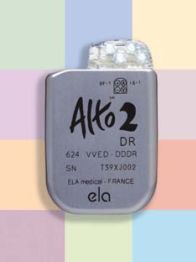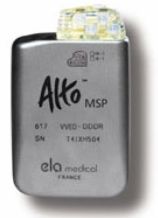Implantable Cardiac Defibrillators (ICDs)
Implantable cardiac defibrillators (ICDs) are devices that detect and treat ventricular tachyarrhythmia.
Tachyarrhythmia is a general term for a variety of abnormally fast heart rhythms that cause the heart to beat more than 100 times per minute.
The aim of the ICD therapy is to rapidly detect the irregular heart rhythm and deliver the appropriate treatment to return the heart rhythm to normal.
If the heartbeat becomes too fast (ventricular tachycardia), the ICD will deliver short runs of fast pacing to restore a normal rhythm; this is called anti-tachycardia pacing. In cases where the heartbeat is too rapid and may cause the patient to die (ventricular fibrillation), the ICD will also give an electric shock (defibrillation) to reset the cells of the heart.

The ICD is implanted into the chest of the patient during a minor surgical procedure. The leads are placed through the venous system into the right ventricle (similar to pacemaker technology). A short stay in the hospital is usually required.
Like pacemakers, there are two types of ICDs.
- Single-chamber devices analyze the electrical signals in the right ventricle and offer arrhythmia therapy.
- Dual-chamber devices analyze the signals of both the right atrium and the right ventricle so as to better identify cardiac rhythm disorders.
While delivering the same therapeutic functions as single chamber ICDs, they optimize the benefits of defibrillation by better distinguishing ventricular tachycardias from supraventricular or sinus tachycardias.
Defibrillation electrodes: in the right ventricle and in the superior vena cava ICD active can Ventricular sensing and pacing electrode Atrial sensing and pacing electrode Dual chamber ICD
Several scientific studies have demonstrated the clinical efficacy of ICDs.The MADIT and AVID studies showed that implantable defibrillators save more lives than antiarrhythmic drugs. The MUSTT study demonstrated that EP studies and ICDs play a significant role in reducing sudden cardiac death among certain patients with coronary artery disease.The most recent study, MADIT II, that tested the mortality benefit of ICDs versus conventional drug therapy in patients that had compromised heart pumping ability following a heart attack, showed a reduction in mortality of 31% with use of ICD therapy.
VVIR - ALTO 2 VR 625
 ALTO 2 VR 625 is an on-chamber’s implantable cardiac defibrillator (ICD).
ALTO 2 VR 625 is an on-chamber’s implantable cardiac defibrillator (ICD).
This ICD uses PARAD/PARAD+ and performs analysis in every cardiac cycle.
It has the capability of “LOW ENERGY SHOCK”, “MEDIUM ENERGY SHOCK” and “MAX ENERGY SHOCK”.
The Rate Responsive mode uses accelerometer.
Holter function and “Follow-Up-Assistant” algorithm.
DDDR - ALTO 2 DR 624
 ALTO 2 DR 624 is a dual-chamber implantable cardiac defibrillator (ICD).
ALTO 2 DR 624 is a dual-chamber implantable cardiac defibrillator (ICD).
This ICD uses PARAD/PARAD+ and performs analysis in every cardiac cycle.
It has the capability of “LOW ENERGY SHOCK”, “MEDIUM ENERGY SHOCK” and “MAX ENERGY SHOCK”.
The Rate Responsive mode uses accelerometer.
Holter function and “Follow-Up-Assistant” algorithm.
MSP - ALTO MSP 617
 ALTO 2 MSP 617 is a bi-ventricular implantable cardiac defibrillator (ICD).
ALTO 2 MSP 617 is a bi-ventricular implantable cardiac defibrillator (ICD).
It recognizes and cures ventricular arrhythmias and resynchronises the ventricles.
This ICD uses PARAD/PARAD+ and performs analysis in every cardiac cycle.
It has the capability of “LOW ENERGY SHOCK”, “MEDIUM ENERGY SHOCK” and “MAX ENERGY SHOCK”.
The Rate Responsive mode uses accelerometer.
Holter function and “Follow-Up-Assistant” algorithm.